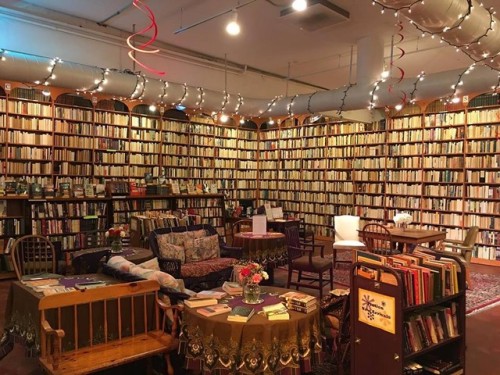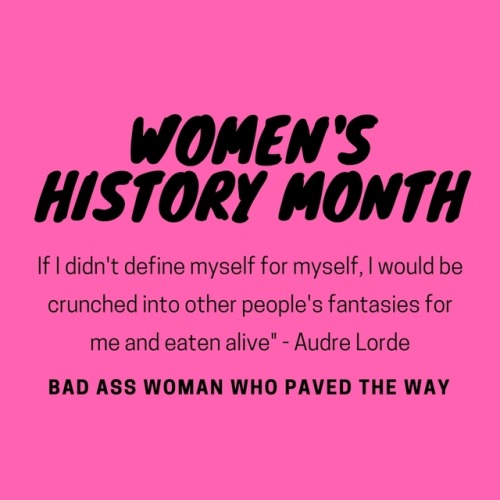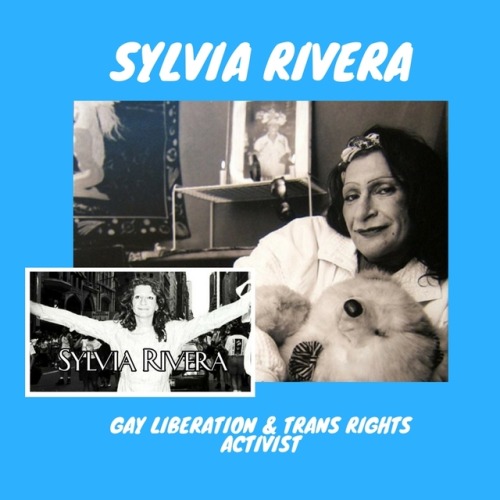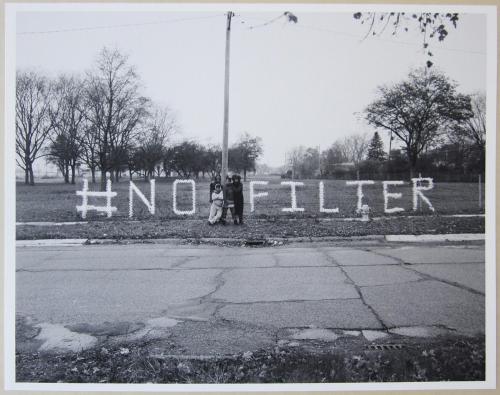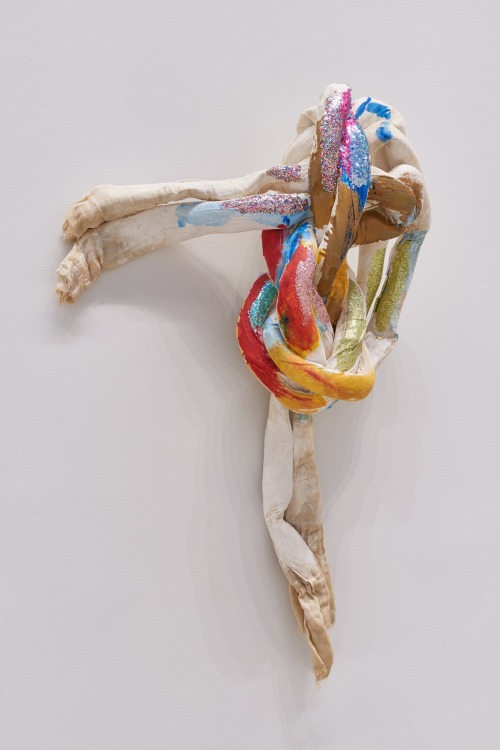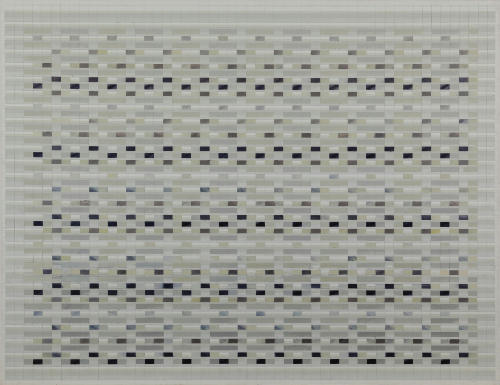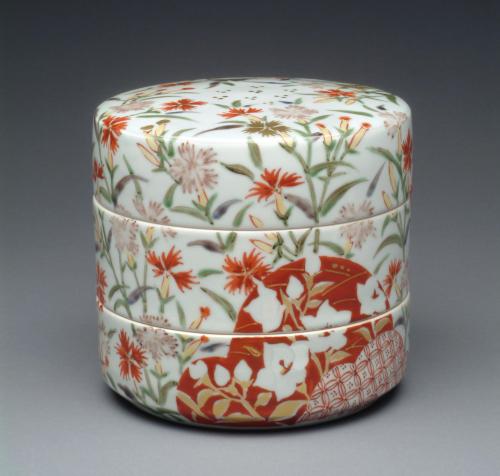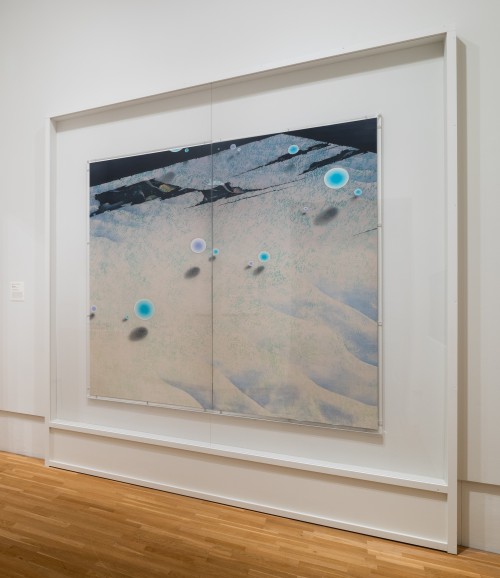#womens history month
Loganberry Books, in Ohio turned every book in their fiction room authored by a male backwards on the shelves to illustrate the fiction gender gap.
In an interview with Cleveland Scene, Logan said the display was “a metaphor of silencing the male voice—at least for this month.”
Post link
How far would you go to save your skin?

Spending some time with my main #WIP tonight, a novel about the story of Anne Boleyn. Working on the particularly trying epic of Cardinal Thomas Wolsey. He sacrificed his prized possessions in order to save his skin from King Henry VIII. Spoiler: it didn’t work.
How far would you go to save your skin? Would you give up your most prized possessions? Do any of your characters do anything crazy to try and save their own skin?
March is Women’s History Month, so I wanted to shine some light on some poppin’ Queer Women of Color who by just existing, or fighting at the grassroots level, have fought for a better more inclusive planet.
Gladys Bentley:
August 12th 1907- January 18th 1960
From way of Philadelphia, Pennsylvania Gladys Bentley was a Blues singer who was very prominent during the Harlem Renaissance. An entertainer of many trades, Bentley was most commonly known for her singing. She broke barriers as a openly queer singer who embraced her masculinity. She often wore clothes that society deemed were only for men, and embraced her community as her performances usually included various drag queens. Along with her musical talents, Gladys Bentley radiated black women masculinity that many had not seen before. Opening the doors for different types of entertainment as well as changing the way we view gender and black women as a whole.
Lorraine Hansberry:
May 19th 1930- January 12th 1965
Born in The Chi, Lorraine Hansberry is a world renowned playwright. She studied at the University of Wisconsin-Madison where she continued in her family’s line of work for political change. Hansberry later moved to New York City and worked for the Freedom Newspaper in which she helped highlight black stories in the US and abroad. Hansberry is most known for her American Classic play, A raisin in the Sun. Hansberry is the first Black woman author to have a play performed on Broadway.
Sylvia Rivera
July 2nd 1951-February 19th 2001
Sylvia Rivera is an LGBT Elder who continues to be written out of history. A New Yorker through and through, Sylvia Rivera was a Trans Activist who was crucial force at the Stonewall Riots. Rivera was a cofounder of the Gay Liberation Front, the Gay Activist Alliance, and alongside Marsha P. Johnson helped found, (STAR) Street Travsvetisties Action Revolutionaries. Sylvia Rivera fought throughout her life to see justice not only for folks with different genders and gender expressions, but for all folks who were living in the world with a marginalized identity.
Bamby Salcedo
Bamby Salcedo is a Trans Activist who is on the streets today organizing for her community. Her work includes her position at Children’s Hospital LA as a Health Educator/HIV Service coordinator. She is the founder of the LA based organization, TransLatin@ Coalition, who advocate for the needs of Trans latinx immigrants in the United States. In 2015 she made headlines when she disrupted the National LGBT Task Force conference to demand that attention be made to the violence that trans folk face everyday. Since then she has been listed in OUT magazine’s 2015 OUT 100 list, as well as speaking at the white house at the US women Summit. You can learn more about the TransLatin@ Coalition here.
Jennicet Gutierrez
A proud immigrant by way of Mexico, Jennicet Gutierrez is a Trans rights and Immigration rights activist who has demanded that her voice be heard. Jennicet is a founding member of the organization, La Familia: Trans Queer Liberation Movement. Gutierrez was also apart of OUT magazine’s 2015 OUT 100, but made national news when she demanded attention from President Obama at a White House Dinner. Gutierrez was criticized by many but highlighted the divide in mainstream gay activism, and grassroots queer and trans activism. You can learn more about La Familia here.
Cecilia Chung
Cecilia Chung is a LGBT Activist who has fought for LGBT rights as well as spreading education and HIV awareness. Chung’s family immigrated from Hong Kong to Los Angeles and now Resides in the Bay Area (AYYYYYY). Cecilia Chung has done extensive work as an HIV educator throughout San Francisco, as well as programming throughout the Transgender Law Center, and the API American Health Forum. Chung has paved the way for many others to follow as the first Trans women and Asian women elected to the SF LGBT Pride Celebration committee, working for the SF health Commission appointed by Mayor Ed. Lee, and the list goes on!
Post link
Otto Hahn won the 1944 Nobel prize of chemistry for the discovery of nuclear fission, which was a joint project with Lise Meitner. Meitner was nominated 48 times, and never won a Nobel.
Don’t forget about all the forgotten Eunices of history
“Somewhere in England, Maj. Charity E. Adams,…and Capt. Abbie N. Campbell, …inspect the first contingent of Negro members of the Women’s Army Corps assigned to overseas service.” 2/15/1945. NARA ID 16214.

Women’s Auxiliary Corps Captain Adams drills her company 5/1943. NARA ID 531334.

“The negro WAC battalion’s first parade on the continent. Rouen, France.” 5/27/1945. NARA ID 175539237
Black Female WWII Unit Gets (Congressional) GOLD!
WWII’s 6888th Central Postal Directory Battalion
By Miriam Kleiman, Public Affairs

“Tech. Sgt. Tommye Berry, Acting 1st Sgt. of the Negro WAC group” 4/16/1945. NARA ID 535929.
The Women’s Army Corps (WAC) was signed into law by President Roosevelt and set to active duty status on July 1, 1943, but this group did not include Black women. First Lady Eleanor Roosevelt and Civil Rights icon Dr. Mary McLeod Bethune (see: related Tumblr post) advocated for the inclusion of Black women who were eager to contribute to the war effort.
Finally, approval was gained, volunteers enlisted, and the battalion trained at Fort Oglethorpe, GA. In February 1945, the women of the 6888th Central Postal Directory Battalion (the self-proclaimed “Six Triple Eight”) deployed - becoming the only all-Black, all-female unit to serve in Europe in WWII. They were led by Major Charity Adams, the highest-ranking Black woman in the US Army during WWII.
The 6888th organized and sorted mail for delivery to U.S. soldiers in Europe. They worked around the clock, fighting not only the mail backlog but also racism, sexism—and the Third Reich.
On March 14, 2022, President Biden signed a bill into law to award the women of the 6888th Battalion a Congressional Gold Medal “in recognition of their pioneering military service, devotion to duty, and contributions to increase the morale of personnel stationed in the European theater of operations during World War II.” Award ceremony date TBA.
The 6888th by the numbers:
- 855 - # of Black women in the 6888th
- 3 - # of months it took them to clear a 6-month backlog of mail.
- 3 separate 8-hour shifts, 7 days a week - work hours.
- 65,000 - # of pieces of mail processed per shift
- 17 million - # of pieces of mail processed by the conflict’s end.
- 77 years - # of years wait for these women to be honored by Congress
The 6888th faced overflowing warehouses stacked with letters and packages for anxiously awaiting GIs. The women of the 6888th knew the importance of such connections to the soldiers and embraced as their motto: “no mail, low morale.” Facing huge volumes of “undeliverable” mail, they developed a tracking system using 7 million servicemember ID cards to correctly route the letters and package.
“The women of ‘Six Triple Eight’ confronted warehouses stacked to the ceiling with letters and packages. These buildings were unheated and dimly lit, the windows blacked out to prevent light showing during nighttime air raids. Rats sought out packages of spoiled cakes and cookies,”the Army said.

Example of the backlog of vast quantities of Christmas mail en route to American soldiers.” NARA ID 111-SC-197654.

“WACs sort packages, taken from the mail sacks by French civilian employees, at the 17th Base Post Office. Paris, France.” NARA ID 175539203.
Continuing legacy of the 6888th:
The 6888th returned to the United States in February 1946 and was disbanded without any public appreciation or official recognition of their work. However, their accomplishments led the General Board, United States Forces European Theater, to note in their December 1945 study of the Women’s Army Corps: “[T]he national security program is the joint responsibility of all Americans irrespective of color or sex” and “the continued use of colored, along with white, female military personnel is required in such strength as is proportionately appropriate to the relative population distribution between colored and white races.”
11/30/2018: monument in Fort Leavenworth, Kansas was made in their honor.
2/25/2009: The 6888th women were honored Arlington National Cemetery’s Women in Military Service for America Memorial.

“Post exchange officer serves the first Coca Cola to Major Charity Adams at the grand opening of the WAC battalion’s new snack bar. Rouen, France.” NARA ID 175539159.

President Obama greets Alyce Dixon, the oldest living Black American WW2 veteran, in the Oval Office, 10/27/2014. NARA ID 176552374.
See also:
- Washington Post story on Romay Johnson Davis: She joined the only Black female unit sent overseas in WWII. Now 102, she’s the oldest living member.
- No Mail, Low Morale: The 6888th Central Postal Battalion,Unwritten Record
- Their War Too: US Women in the Military During WWII,The Text Message
- Pictures of African Americans During World War II
- African American Women in the Military During WWII, Blog Post
- 6888th Central Postal Directory Battalion, US Army Center of Military History
- The SixTripleEight: No Mail, Low Morale, The National WWII Museum
- Women of the 6888th Central Postal Battalion
- H.R.1012 – ‘Six Triple Eight’ Congressional Gold Medal Act of 2021, Congress
The 4th in our series celebrating Black History Month (Feb) and Women’s History Month (March).

WOMEN’S HISTORY MONTH
Feminine Sleuth Gets State Post
In May, 1945, 37-year-old Evelyn Hazelton was appointed the first woman agent of the Minnesota State Bureau of Criminal Apprehension. “The fact she is a woman isn’t going to keep Mrs. Hazelton from performing jobs that are usually entrusted to the male agents of the bureau,” a Minneapolis Tribune article said. Evelyn was expected to attend classes with male agents on fingerprinting, firearms, judo, photography, and recognizing and preserving evidence. While trained for every type of police investigation, she was to concentrate on cases involving women and girls. Evelyn began working as a stenographer for the department in 1938, becoming familiar with case records, agent reports, and criminal investigation procedure. At night she studied law at the Minneapolis College of Law. She worked as an investigator for the Bureau for several years before returning to office work in state government. She retired as secretary of the US General Services Administration in the 1970s and died in 1976 at the age of 68.
Photo of Evelyn Hazelton from the Minneapolis Newspaper Photograph Collection in the Hennepin County Library Digital Collections.



Ever since Harriet Beecher Stowe helped found the magazine in the spring of 1857, women have been integral to The Atlantic.
During the Cold War, a concerned Eleanor Roosevelt watched Russian influence spread to the world’s “uncommitted nations” and called for a re-dedication to the ‘American Dream’ in the April 1961 issue. In our August 1932 issue, Hellen Keller wrote a piece titled “Put Your Husband in the Kitchen,” in the form of humorous Depression-era business advice-giving.
The covers featured here include one from August 1968 with songwriter and activist Joan Baez, in which she shares excerpts from her journal; Wendy Kaminer on “Feminism’s Identity Crisis” leading the October 1993 issue; and the July/August 2013’s cover story by Anne-Marie Slaughter, “Why Women Still Can’t Have It All,” arguing that true equality entails sweeping policy changes. Do you have a favorite female Atlantic writer or artist? Comment below.

Video Dames: The History Of Playable Female Protagonists
The prelude episode to my new 50-part series on the history of playable female characters from the ‘80s!
Have you ever wondered what was the first game that let you play as a woman? The answer is in my new video!
Emily Dickinson was born in 1830 in Amherst, Massachusetts and is regarded as one of the most important American poets. At the end of her life, Emily spent most of her days at home living mainly as a recluse. When she died at the age of 55 in 1886, she left behind 1,800 poems.
"Hope is the thing with feathers
That perches in the soul,
And sings the tune without the words,
And never stops at all,
And sweetest in the gale is heard;
And sore must be the storm
That could abash the little bird
That kept so many warm.
I’ve heard it in the chilliest land,
And on the strangest sea;
Yet, never, in extremity,
It asked a crumb of me.“

Women’s History Month
Margaret Palm-African-American History-Civil War
Margaret Palm lived in Gettysburg, Pennsylvania, along with 190 other free African-Americans, making up about 8% of the town’s population. She rented a white shack on the west end of Emmitsburg Road, and lived there with her husband, Alf Palm and their one child.
During the months leading up to the Battle of Gettysburg, African-American members of the Gettysburg community began fleeing their homes for fear that their freedom and safety would be in jeopardy, once the Confederate army invaded their little town.
There are many stories that surround the persona of “Mag Palm”, as she was called, some perhaps mere legends passed on by other civilians over the years. One legend refers to Mag as “Maggie Bluecoat”, referring to the story that she wore a blue coat of an officer of the War of 1812, and carried a musket while aiding other slaves in their fight for freedom from slavery.
One account, however, of an attempted kidnapping of Mag Palm by two local men is well known and well documented. Many free African-Americans were often victims of kidnapping by their own white neighbors, often to be sold off to Southerners for slavery.
Like the majority of African-American women in the Gettysburg community during the Civil War years, Mag made a hard living by scrubbing floors and washing the clothes of her white neighbors. One cold winter night in 1858, three years before the war even began, upon returning home from picking up her pay from one of her employers, Mag was attacked by two men who tried to tie her hands and take her away. . Mag managed to fight both men off with the help of another neighbor, John Karseen, a store owner in town, who witnessed the attack. Years later Mag Palm was photographed demonstrating how the men bound her hands and documented the attack for history.
During the battle, her home on Emmitsburg Road was occupied by the Union army and eventually destroyed in the fighting on the last day of the Battle of Gettysburg, July 3, 1863. Despite hardships in her own marriage, as her husband drank and was often prone to fits of rage, she managed to buy her own home again along Long Lane, a black community in the town, after the battle was finally over. She continued to struggle financially and was never able to stop beating rugs and scrubbing floors for a living.
Mag Palm passed away in October of 1896 from a heart ailment. She was buried in the Lincoln Cemetery in Gettysburg, among many other African-American civilians of the town. Her courageous story of struggle and survival is only one of the many forgotten African-American civilian stories of the women who lived and survived the battles fought right in their own communities, during the Civil War.
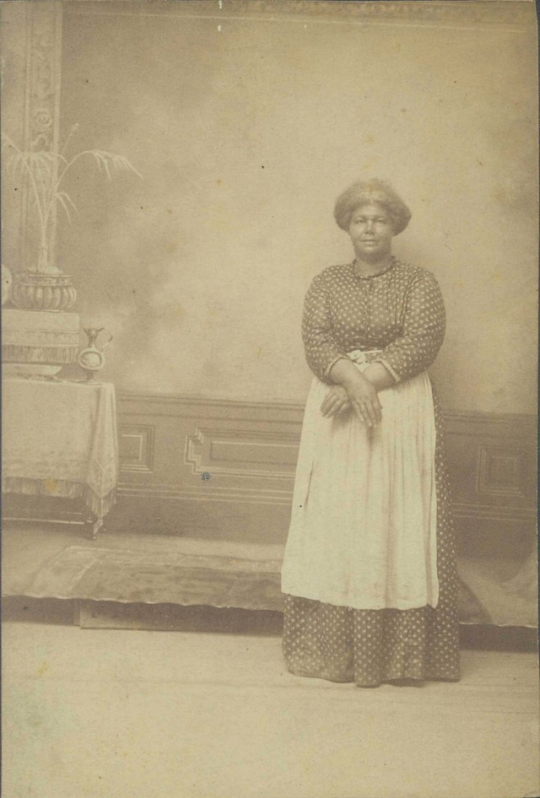

March is Women’s History Month
Mary Elizabeth Bowser-Freed Slave, Union Spy, and Abolitionist

Mary Elizabeth Bowser was born Mary Jane Richards on May 17, 1846, near Richmond, Virginia. She was born a slave to the Van Lew family, Eliza Baker and John Van Lew, of Richmond, Virginia.
Records show that Mary was baptized at St. John’s Church, the white congregation of the Van Lew family, as opposed to the First African Baptist Church in Richmond. This fact proves that Mary was treated differently by other slaves, by the Van Lew family from birth.

When she was of age, Eliza and John’s daughter, Elizabeth, sent Mary north to get an education. In 1885, she sent her to Liberia for missionary work and she did not return to the Van Lew home until 1860 again.
A few days after the battle of Fort Sumter, Mary married Wilson Bowser on April 16, 1861, in the same church she was baptized in. The Civil War had just begun.
During the war, Mary was instrumental in helping Elizabeth with her spy operation and aided her in helping escaped slaves take refuge in the Van Lew mansion. Mary, as well as many of the slaves freed by the Van Lew family, completed dangerous missions to get information to General Grant about the movements of the Confederate army. Mary even managed to obtain a position as a servant in the household of Jefferson and Varina Davis. She worked directly for Varina Davis and managed to learn about important strategies and plans of the Confederate government.
Soon after the war, Mary Bowser worked as a teacher to freed slaves in Richmond and, in 1867, founded her own school in Georgia. She alone taught young children and adults, all former slaves, to read and write.
A letter surviving with the date, June 1867, stated her new name as Mary Garvin and the intention that she would be joining her new husband in the West Indies.
The year of her death is unknown, but a memorial plot was placed in her memory at Woodland Cemetery in Richmond, Virginia. It honors her memory as an agent who helped saved the Union during the Civil War. The stone reads, “Mary Elizabeth Bowser, Born 1840, Union Military Intelligence Agent, She risked her life and liberty so that all could know freedom.”

Author, Kate Chopin, “The Awakening”, 1899
Kate Chopin was born Katherine O’Flaherty on February 8, 1850, in Louisiana. She was a novelist and short story writer, and is considered the first Southern feminist writer of the 20th-century. Her book, “The Awakening”, was considered ahead of its time and caused such controversy, that it ended Chopin’s writing career. After being banned several times, it remained out of print until the 1970’s. Today, the book is considered a classic in feminist fiction.
“Despondency had come upon her there in the wakeful night, and had never lifted. There was no one thing in the world that she desired…The children appeared before her like antagonists who had overcome her, who had overpowered and sought to drag her into the soul’s slavery for the rest of her days. But she knew a way to elude them. She was not thinking of these things when she walked down to the beach.
The water of the Gulf stretched out before her, gleaming with the million lights of the sun. The voice of the sea is seductive, never ceasing, whispering, clamoring, murmuring, inviting the soul to wander in abysses of solitude. All along the white beach, up and down, there was no living thing in sight.”
–“The Awakening”, 1899


Wanda Gág, who was born on this day in 1893, is publicly on record as a feminist and standard bearer for the “New Woman”—a twentieth-century ideal emphasizing autonomy and individuality. Here she presents an image of herself engaged in the act of drawing this very work.
“Self-Portrait in Dresser Mirror: Cream Hill,” 1930, by Wanda Gág
Post link
Fern Isabel Coppedge was an Impressionist painter who studied at Pennsylvania Academy of the Fine Arts and the Philadelphia School of Design for Women (now Moore College of Art & Design) before moving to New Hope, Pennsylvania, in 1929. She was one of the few women artists associated with the Pennsylvania Impressionist group and became well-known for her paintings of Bucks County landscapes, winter scenes, and marine subjects. This particular work depicts the harbor in Gloucester, Massachusetts, where she spent many summers. Although undated, the work’s imaginative color scheme suggests that Coppedge painted it fairly late in her career.
“Drying Sails, Gloucester” date unknown, by Fern Isabel Coppedge
Post link
Happy International Women’s Day! We can’t think of a better moment to join the National Museum of Women in the Arts in their effort to highlight the imbalance in gender representation in the arts. Can you name 5 Women Artists? Follow along this month as we share more of the amazing work by women artists in our collection. And visit these five artists and more in our galleries during your next visit.
“A Message in Nestle Water Bottles from Shea Cobb, Amber Hasan, Macana Roxie and LaToya Ruby Frazier at Sussex Drive and West Pierson Road, Flint MI,” 2017, by LaToya Ruby Frazier. "Portrait of Cecil Kent Drinker,“ 1891, by Cecilia Beaux. ”Epsilon,“ 1972, by Lynda Benglis © Lynda Benglis / Licensed by VAGA at Artists Rights Society (ARS), New York. ”notation in x, y, z,“ 2015, by Tanya Goel © Tanya Goel. ”Two-Tiered Food Box (Picnic Box) with Design of Pinks and Bellflowers,“ around 2000, by Keiko Mori.
Post link
Otani Chie created the abstract shapes on this textile with a wax-resist (rōzome) technique. She first covered select areas of the cotton fabric’s surface with molten wax to prevent them from absorbing dye. Then she dipped the piece in a dye vat and repeated the process to create each colored form.
See this textile in our installation “Kōgei: Art Craft Japan.”
“Pleasure in Land and Sea,” 1995, by Otani Chie © Otani Chie
Post link
Doris Caesar once said, “I try to be emotional, and yet get away from reality.” Characteristic of her expressive work, this figure is elongated and gaunt. The surface of the piece is covered with marks left by the artist’s hands as she worked the clay that would later be cast in bronze. With her slumped posture, drooping shoulders, and downturned facial features, the widow’s body appears to convey the emotional weight of her grief.
See this sculpture in our newest installation “Elegy: Lament in the 20th Century.”
“The Widow,” around 1930–50, by Doris Caesar
Post link
Philadelphia-born Sarah Dodson studied in the city before moving to France and England, where she developed her talent for imaginative historical figure painting. In this picture she references the famous honey that the beekeepers of ancient Athens produced in the Hymettus mountains. Visit this portrait in our American galleries.
“Honey of the Hymettus,” 1891, by Sarah Paxton Ball Dodson (On loan from the Thomas H. and Diane DeMell Jacobsen Ph.D. Foundation)
Post link
Happy Women’s History Month! We’ll be celebrating all month long by sharing some of the amazing work in our collection and on view by women artists.
First up is American Modernist Georgia O’Keeffe. After moving to New York City in 1918, O’Keeffe began spending summers at Alfred Stieglitz’s family home on Lake George in upstate New York. “From the Lake No. 3” is one of her most abstract paintings inspired by those surroundings. She embraced the colors of the region, evoking a sense of the place without depicting its literal qualities. See this painting on view in our American galleries.
“From the Lake No. 3,” 1924, by Georgia O’Keeffe
Post link

